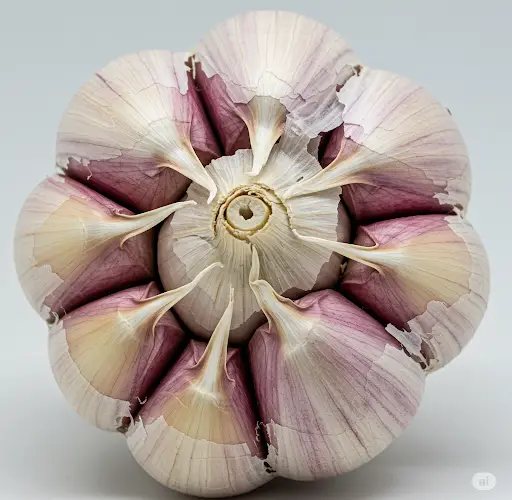Garlic is a crop that rewards patience and proper care. From fall planting to late-spring maintenance, each step plays a critical role in bulb development. But there’s one key action—often overlooked by home gardeners—that can make the biggest difference in producing large, healthy garlic bulbs: the final feeding.
This late-stage boost gives garlic the nutrients it needs right when the bulbs are starting to form and swell. Done at the right time, this simple step can dramatically increase both the size and quality of your harvest.
Here’s everything you need to know about giving garlic its last and most important feeding.
Why Timing Matters for Garlic Feeding
Garlic goes through several distinct growth phases. After overwintering, it puts energy into leaf production in early spring. Each healthy leaf is a sign of strong growth and directly influences bulb size. Around late spring—typically May to early June in most climates—garlic transitions into the bulbing stage, where energy shifts from the leaves into the underground cloves.
This stage is critical. If the plant doesn’t have enough nutrients, especially nitrogen, potassium, and sulfur, bulb development can stall, resulting in small or underdeveloped heads.
Feeding garlic once more at the beginning of the bulbing phase gives the plants a final push to reach their full potential.
Signs It’s Time for the Final Feeding
Not sure when to feed? Look for these signs:
-
The garlic has 6–8 mature green leaves.
-
The days are getting longer and warmer.
-
Scapes (flower stalks) are beginning to form on hardneck varieties.
This is the window—just before or right as the bulbs start forming—that you want to take advantage of. Waiting too long can lead to wasted effort, while feeding too early means the nutrients are used for leaf production, not bulb growth.
Best Fertilizers for Final Garlic Feeding
At this stage, your garlic needs a balanced but bulb-friendly nutrient mix. You want something that promotes root and bulb development—not just leafy growth.
Here are some top options:
1. Compost Tea or Worm Castings Tea
Rich in micronutrients, these liquid feeds help improve soil biology and gently nourish plants. Apply as a soil drench around each garlic plant. Bonus: they won’t burn the roots.
2. Granular Organic Fertilizer (Low Nitrogen)
Look for a balanced fertilizer with an NPK ratio such as 4-6-8 or 3-6-6. The lower nitrogen reduces the risk of soft bulbs, while the phosphorus and potassium support robust clove development.
3. Wood Ash (in moderation)
If your soil is acidic, a small sprinkling of wood ash around garlic plants can raise potassium levels. Use sparingly and avoid if your soil is already alkaline.
4. Sulfur-Rich Amendments
Garlic loves sulfur—it enhances flavor, disease resistance, and bulb density. Products like gypsum or elemental sulfur (if needed based on soil test) can be lightly worked into the topsoil.
How to Apply the Final Feeding
-
Water before feeding: Make sure the soil is moist before applying any fertilizer to avoid burning the roots.
-
Side-dress granular fertilizers: Sprinkle the recommended amount in a ring around each plant, about 2–3 inches from the stem. Gently work it into the top layer of soil.
-
Apply liquid feeds: Pour compost tea, fish emulsion, or worm tea around the base of each plant, soaking the root zone.
-
Repeat once if needed: For long-maturing varieties or poor soils, a second light feeding 10–14 days later may help, especially if the garlic still looks vibrant and upright.
Don’t Forget to Remove Scapes
If you’re growing hardneck garlic, be sure to remove the scapes once they curl. These flower stalks draw energy away from bulb growth. By snipping them off, you redirect nutrients into the developing bulbs. Plus, garlic scapes are a delicious bonus crop!
Other Tips to Maximize Bulb Size
-
Water deeply during the bulbing phase, but let the soil dry slightly between waterings to prevent rot.
-
Weed regularly, as garlic doesn’t compete well with weeds.
-
Mulch lightly to conserve moisture without crowding the stems.
-
Stop watering 2–3 weeks before harvest to allow bulbs to cure in the ground.
When to Harvest
Garlic is typically ready for harvest when 4–5 lower leaves have browned, but the upper leaves remain green. Each leaf represents a bulb wrapper, so harvesting too late can reduce storage life.
Final Thoughts
The final garlic feeding is the gardener’s last chance to influence the size and quality of the bulbs. When done at the right time with the right nutrients, this simple step can dramatically boost your harvest. With a bit of attention now, you’ll be rewarded with big, flavorful garlic bulbs that store well and impress at the dinner table.
Give your garlic this final boost—and watch it thrive.



